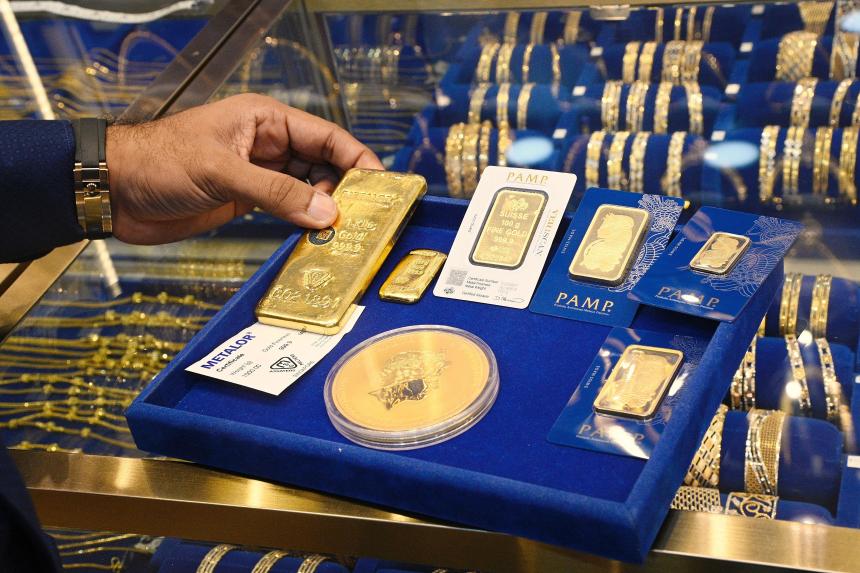MUMBAI – For many investors, gold is looking hot right now. The precious metal just touched an intraday record of US$2,135.39 an ounce thanks in part to its haven status: The more volatile the world gets, the better gold tends to do.
Bullion has rallied almost 16 per cent since early October, a surge that was initially sparked at the start of the Israel-Hamas conflict, but has since been driven by bets the United States Federal Reserve will shift to monetary loosening early in 2024.
So, is the time right for retail investors to start putting money in the asset? Or is it best to keep your exposure confined to your jewellery box?
Here is what you need to know:
Why is the price of gold rising?
It last hit a record US$2,075.47 an ounce in August 2020, when the Covid-19 pandemic boosted haven demand.
This time around, its rise has been driven by geopolitical risk and traders aggressively pricing in rate cuts from March 2024.
Fed chairman Jerome Powell last week said the central bank’s policy rate is “well into restrictive territory” in comments that are being interpreted as largely dovish by markets.
Lower borrowing costs are typically positive for non-interest bearing bullion.
In India, the second-biggest consumer of gold after China, the metal hit a fresh high in the local currency in November.
Why would you buy gold now?
The backdrop for gold is looking supportive going into 2024 driven by the Fed’s interest rate path and higher geopolitical and economic risks, said ANZ Banking Group commodity strategist Soni Kumari.
“On top of that, central bank purchases are going to sustain next year”, and can potentially offset any weakness in physical demand, she added.
More than just a symbol of wealth, gold has a rich cultural history across Asia.
Indians collectively own the biggest private holding of bullion in the world, and the metal holds a central role in rituals as well as being a portable and practical investment.
Gold is a long-term asset, and for Asians it has intergenerational value, according to Mr P. R. Somasundaram, regional chief executive for India at the World Gold Council.
Many of gold’s biggest enthusiasts also see it as protection against the collapse of fiat currencies.
How do I buy gold?
Gold exchange-traded funds (ETFs) are a key investment option for both institutional and individual investors.
This is more sought-after in North America and Europe, which together make for about 95 per cent of the world’s total ETF holdings by volume.
Other ways to invest include Internet brokerages – who buy, sell and hold physical bars in vaults for customers – and gold-backed stablecoins, a form of cryptocurrencies whose price moves in line with the metal.
In some locations like Hong Kong, consumers have the option to invest in gold accounts with banks, where they can choose to have part of their savings accounts in either local currency or bullion.
The equities of gold miners usually have strong correlations with gold prices, making them another alternative for investors wanting the exposure.
But the gold stocks also correlate with the underlying equity markets, and their valuations differ based on their financial fundamentals.
A simple way to add gold to your portfolio is to visit your nearest jewellery store and buy bracelets, rings or coins.
Most purchases are made for weddings in countries such as China and India. Shoppers in Thailand and Vietnam prefer coins and bars.
What do I need to be aware of?
Gold buyers need to watch out for purity and quality.
“This is clearly the easiest thing investors fall prey to, just because they are getting the metal at a lower price or at a discount, or without a bill in order to avoid taxes,” said Mr Somasundaram.
Be it a jewellery store or a digital platform, consumers should buy from reputed sellers – fake products and scams proliferate when an asset class is rallying.
Those buying gold in bar, coin or jewellery form can also face premiums over the spot price that cannot always be recouped on resale.
“People buying physical gold should shop around when they buy and also shop around when they sell,” said Mr Adrian Ash, head of research at brokerage BullionVault.
How do I judge gold’s quality?
For retail investors, it is easiest to think about purity in terms of carats. Almost all investment grade bars are 24K – the purest – with other metals making up less than a 1 per cent of the total.
Less pure forms are typically used for jewellery, as 24K gold is too soft for practical purposes. In Asia, where it is seen as an investment, most items are 18K gold and above – at least 75 per cent pure.
Different countries set minimum-accepted purity standards for gold.
In the United States, 10K is the legal minimum, while in France, Britain, Austria, Portugal and Ireland, 9K is the lowest.
Bars minted by London Bullion Market Association accredited refineries are the most prized, given the companies must undergo annual audits to ensure they meet standards on purity and responsible sourcing.
Other markets, including Istanbul and Dubai, maintain similar lists. BLOOMBERG

